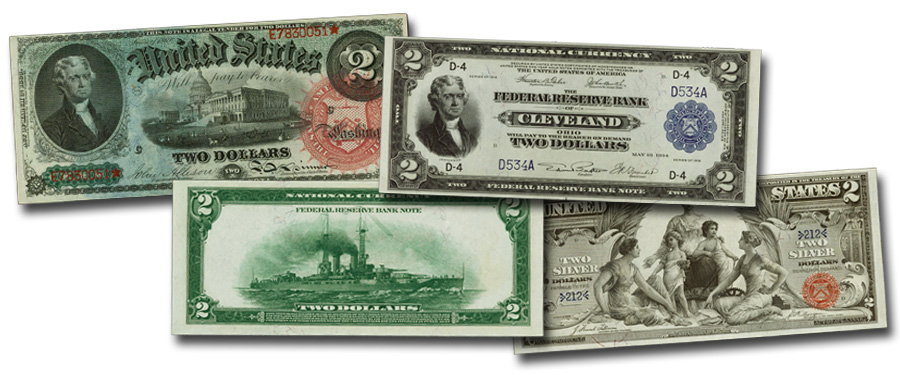
This week we conclude our article on building a collection of Large Size $2 notes.
Jumping over to National Banknotes, among the most popular notes in American paper money collecting are the $2 National Banknotes of 1865 and 1875 known as the “Lazy Deuce” for its distinctive sideways number 2 boldly featured on the face. These notes are beautiful when bright and clean, especially if you find one with blue anti-counterfeiting paper. A nice VF 30 will cost in the neighborhood of $5,000 for a common bank. Gem 65 examples are very rare. When available they can reach into the mid five figures.
Next up are the Silver Certificates. The 1886 Deuces are known as “Hancocks” and portray General Winfield Scott Hancock. These are popular notes with an ornate design and often display great color. This is another type that can be collected as one example of the design or with multiple seal types including small red, large red spiked, and large brown spiked. Again, if you can afford to, try for one of each. Fr. 240 and Fr. 241 (small red) will cost about $1,400 in VF 30 and around $5,800 for a Gem 65. Fr. 242 is the best option for the large red spiked seal and if you only want one note for the design this is what I suggest. A nice VF 30 will again cost about $1,400. Gem 65 notes are available for a little over $5,000. Lastly, large brown spiked seal notes are represented only by Fr. 244. With just around 200 examples presently known they command a premium over the others in higher grade. VF 30 will cost roughly $1,500. Expect a Gem 65 to cost between $9,000 and $12,000.
The 1891 Series $2 Silvers feature William Windom and are thus referred to as “Windom Notes.” They are represented by numbers Fr. 245 and Fr. 246. Both are the same design and seal type. In VF 30 each will cost roughly $1,500. Expect to pay about $7,500 for a Gem 65.
Among the most popular series in our hobby are the 1896 Silver Certificates, known as the “Educational Series.” The $2 denomination, Fr. 247 and Fr. 248, is one of the most ornately designed notes in American paper money. Patience will be required to find truly choice examples for the grade. Both Friedberg numbers cost about the same. A nice VF 30 is going to cost about $2,500. A Gem 65 will easily set you back about $10,000. These notes are ever popular. It could be money well spent.
The final large size $2 Silver Certificate is from the Series of 1899. This long running series is represented by Fr. 249 to Fr. 258. High grade examples can be very attractive. Make sure your example has bright paper and a deep blue overprint. A VF 30 Fr. 258 is only about $400. A Gem 65 is a steal at under $2,000.
Another very popular $2 type is the Treasury Notes of 1890 and 1891. These notes, known as “McPhersons,” feature the portrait of Civil War General James McPherson. The 1890 Series notes come with a beautifully ornate back design as well as two seal types, large brown spiked and small red scalloped. The 1891 Series comes with an open back design and small red scalloped seal. If you have the means, I suggest you collect one of each. If you can pick only one, pay up and find a nice 1890 with large brown spiked seal. Fr. 353 is the best option with VF 30s costing around $4,000. A Gem 65 is another big one in the neighborhood of $40,000. Fr. 355 (ornate back, small red scalloped) is a tough note with just over 100 known. A VF 30 will run about $4,000. A Gem 65 will run into the mid five figures if you can find one. If you are like most of us, and budget is a priority, 1891 Series notes are the more frugal option. Fr. 357 is the most available note for the design. A VF 30 will cost roughly $1,200. Gem 65 notes are available at around $4,500.
Last, but certainly not least, are the $2 Federal Reserve Bank Notes of 1918. These hugely popular notes are known as “Battleships,” due to the early 20th century New York Class battleship displayed on the back. Here is a chance for some personalization if you have a favorite Federal Reserve bank — you could find the one for your geographic area. These notes are available for all 12 districts. A nice VF 30 will cost about $800. For those looking for a Gem 65 to represent the type, Fr. 757 provides many high grade notes for around $3,000.
So that is a basic guide to collecting the $2 series of large size notes that includes many iconic and beautiful designs. There is also plenty of variety, giving you the opportunity to play around with different seal types and design variations. A basic design type set in Very Fine 30 can probably be built within a couple of years for under $20,000. Those up to the challenge and with a decent chunk of change to play with can build a Gem 65 (or thereabouts) set, including multiple seal types and design variations, for roughly $200,000. This undertaking will probably take several years. So if you feel so inclined, go out and find that first note for your new set!
Happy collecting!





